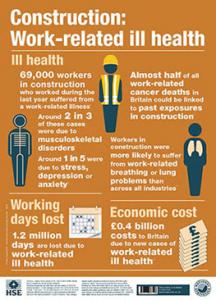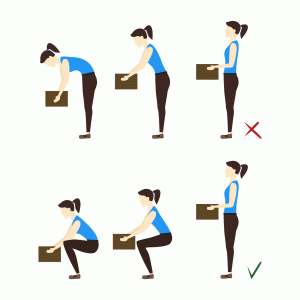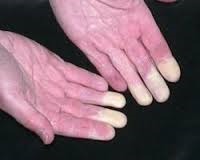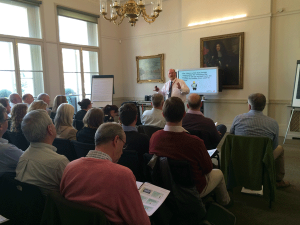Minister sets out priorities for health
The Minister of State for Disabled People, Health and Work, Penny Mordaunt MP, recently launched a new strategy for health in Britain’s workplaces, alongside HSE Chair Martin Temple, HSE Chief Executive Richard Judge.
Held at the Nova Victoria construction site in London, the Heath and Work strategy engagement event allowed a small selected audience to hear the key highlights of the initiative, which supports the existing Helping Great Britain Work Well umbrella strategy launched last year.
Health and Work is focused on reducing work-related stress, lung diseases and musculoskeletal disorders, in response to statistics that suggest stress and musculoskeletal disorders account for around 80% of all working time lost due to illness, with around 12,000 deaths each year from occupational lung diseases, accounting for 90% of estimated deaths related to past exposures at work.
So this week I thought I would remind you all of the need to look at Health in the same way as you do Safety.
This week’s 2 recent HSE case look at recent cases where there were life changing injuries
- Two of the volunteer students drank a solution with 100 times the amount that should have been taken as part of the experiment. They immediately suffered from dizziness, blurred vision, vomiting, shaking and rapid heartbeat.
- Rafal Myslim was standing on the fragile roof when the asbestos sheeting gave way and he fell 7.5m onto a concrete floor, hitting a number of pipes within the building on the way down
As ever, if you have a subject that you would like us to cover one week, please contact us by phone 01458 253682, email or via our Facebook page or by Twitter
Minister sets out priorities for health
As we stated earlier, The HSE Priorities, especially for the construction sector, during 2017 onwards are heavily biased towards action on health risks. The first of the three priorities is “reducing incidents of ill-health, with a particular focus on occupational lung disease and musculoskeletal disorders”.
HSE have stated that they will deliver the priority by “directing inspection and enforcement at those failing to manage and control health risks during refurbishment and licenced asbestos removal”.
HSE Inspectors will:
- Visit duty holders to review their health risk management arrangements; and
- Work with the Health in Construction Leadership Group in promoting the ownership by industry of good health risk management, and the development of case studies and health-specific leading indicators.
The shift of emphasis to ‘health’ issues is being led by the industry Health in Construction Leadership Group (HCLG) which has set itself the mission of:
Uniting the construction industry in order to eradicate the ill-health and disease caused by exposures to health hazards on building sites… and making construction the leading industry for occupational health and disease prevention by 2025 – the construction 2025 initiative
The HCLG plan is to achieve a cultural shift within the construction sector so that health is “managed like safety”.
So let us take another look at some of the main health problems and what we can do to avoid them.
Dust
Many of the health threats are fairly obvious such as dust. But some dusts are more dangerous than others:
Silica Dust Clouds
The extremely common natural substance Silica is found in stone of all sorts on work sites. It’s released into the air during processes like grinding, sawing, demolition, power cutting, dumping, loading and plenty more.
When Silica is breathed in a lot over time, it causes all kinds of nasty conditions, from silicosis to lung cancer.
The HCLG website includes a useful short awareness video on construction dust.
Is Face Fit Testing a legal requirement?
Yes, face fit testing is a legal requirement for anyone who wears a tight (or close) fitting mask for work.
The supporting guidance for COSHH (Control of Substances Hazardous to Health), CLaW (Control of Lead at Work), CAR (Control of Asbestos Regulations) and the Ionising Radiation Regulations, stipulate that fit testing should be carried out as part of the initial mask selection process. This ensures that inadequately fitting face pieces are not selected for use.
The Wilkins Safety Group, we can now offer this service.
Please see later, or click here
The emphasis on lung disease in construction will be supported by further action on manual handling risks by working with supply chains to reduce risks from manual handling.
Bad Manual Handling
Health and social care more than any other industry, has workers taken out by musculoskeletal problems developed over time.
More than one third of all reportable ‘Over Three Day’ injuries and nearly 10% of ‘Major Injuries’ are associated with manual handling. Many injuries are cumulative, resulting from repeated exposure to manual handling operations. Sprains and strains arise from the incorrect application and/or prolongation of bodily force. Poor posture and excessive repetition of movement can be important factors in onset of injuries.
When bending, lifting, twisting, carrying, and dozens of small movements with heavy or even light loads are carried out repetitively over time, one day it takes its toll!
So what should you do?
Avoiding hazardous Manual Handling
Ask yourself can the movement etc. of loads be eliminated altogether? If the answer is no then ask can the operations be automated or mechanised?
Assessing hazardous Manual Handling
Where a possibility of injury from manual handling is indicated, a more specific assessment should be carried out. This is distinct from the everyday judgements which supervisors and others will have to make dealing with Manual handling. It needs to be broad in approach, identify measures to deal with problems likely to arise and include training provisions. Industry specific data and assessments might prove useful sources of information. The assessment should be recorded and kept readily accessible as long as it remains relevant. It should be noted that assessment is not an end in itself, merely a structured way of analysing risks and pointing the way to practical solutions.
Too Much Noise and Vibration
What is the problem wit h noise?
h noise?
Noise is part of everyday life, but too much noise can cause permanent and disabling hearing damage. This can be hearing loss that gets worse over time, damage caused by sudden, extremely loud noises, or tinnitus (permanent ringing in the ears).
With hearing damage, conversation becomes difficult or impossible, your family complains about the television being too loud, you have trouble using the telephone, and you may be unable to sleep. By the time you notice, it is probably too late.
However, there is no need for your hearing to be damaged by your work – your employer has a duty to protect you and should be working on measures to reduce the risk. You can play a part in helping your employer to protect you.
Is there a noise problem where I work?
If any of the following apply, your employer would be expected to be doing something about noise:
- the noise is intrusive – like a busy street, a vacuum cleaner or a crowded restaurant – or worse, for most of the working day;
- you have to raise your voice to have a normal conversation when about 2 m apart, for at least part of the day;
- you use noisy powered tools or machinery for over half an hour a day;
- the type of work is known to have noisy tasks, e.g. construction, demolition or road repair; woodworking; plastics processing; engineering; textile manufacture; general fabrication; forging or stamping; paper or board making; canning or bottling; foundries; waste and recycling;
- there are noises because of impacts (such as hammering, drop forging, pneumatic impact tools etc.), explosive sources such as cartridge-operated tools or detonators, or guns.
Another sign that something should be done about the noise is having muffled hearing at the end of the day, even if it is better by the next morning. If you have any ear or hearing trouble, let your employer know.
Feeling those bad vibrations?
Two million people in the UK are at risk of developing hand-arm syndrome (HAVS) or carpel tunnel syndrome from using power tools like sanders, hammer drills, grinders and dozens more.
At a glance it may seem vibrations from power tools are a minor concern, but too much and you can develop serious and debilitating conditions – like hand-arm Vibration syndrome (HAVS) or carpel tunnel syndrome.
Their more unpleasant nicknames illustrate better how bad these injuries are – ‘vibration white finger’ or ‘dead finger’. Yep, ‘dead finger’ doesn’t sound too minor does it?
HAVS causes pain and distress, reduced ability to work in damp or cold conditions, or to do any fine work with the fingers, and loss of strength in the hands – all pretty much what a good builder needs for their livelihood!
So what’s the threat and how can you avoid it?
6 Signs Your Workers are at Risk of HAVS
- They work in construction – that’s right, everyone in construction is at risk of HAVS, it’s the most common industry for the problem
- Your employees complain about numbness or tingling in their hands and fingers when they’ve been using vibrating tools
- They hold work pieces that vibrate because they are being processed by pedestal grinders or other power machinery
- They operate any hammer action tool for more than 15 minutes a day
- They use rotary or other action tools for over 1 hour a day
- They regularly use hand-held or guided power tools like Sanders, grinders, disc cutters, Hammer drill etc.
So you can see how the HSE can say 2 million people in the UK are at risk of getting HAVS – but before you panic, that’s 2 million at risk! You can take these steps to dramatically reduce that risk. Pay careful attention to any signs of HAVS symptoms;
4 Early Symptoms of HAVS
- Numbness or tingling in fingers
- Reduced sense of touch
- Hands losing strength
- Whiteness in your fingers, and then redness and pain
But you should be taking action a long time before you see symptoms. They can show up after months or years of exposure. A little too late. Instead, take these precautions and make sure all your workers know them well and follow them;
7 Ways to Reduce the Risk of HAVS
- Reduce the time you use a tool in one go – vary, alternate and break up jobs
- Use low-vibration tools wherever it’s possible
- Maintain and check tools – when they’re not taken care of properly wear, tear and faults can cause extra vibrations
- Don’t force a tool too much
- Don’t grip a tool harder than is necessary to do a job
- Try to keep the tool handles not too cold – so store them inside when possible
- Always keep yourself warm and dry – this helps the blood circulation in your hands and arms
Work related stress
 Well-designed, organised and managed work is good for us but when insufficient attention to job design, work organisation and management has taken place, it can result in Work related stress.
Well-designed, organised and managed work is good for us but when insufficient attention to job design, work organisation and management has taken place, it can result in Work related stress.
Work related stress develops because a person is unable to cope with the demands being placed on them. Stress, including work related stress, can be a significant cause of illness and is known to be linked with high levels of sickness absence, staff turnover and other issues such as more errors.
Stress can hit anyone at any level of the business and recent research shows that work related stress is widespread and is not confined to particular sectors, jobs or industries. That is why a population-wide approach is necessary to tackle it.
Definition of stress
HSE’s formal definition of work related stress is:
“The adverse reaction people have to excessive pressures or other types of demand placed on them at work.”
Stress is not an illness – it is a state. However, if stress becomes too excessive and prolonged, mental and physical illness may develop.
There is a difference between pressure and stress. Pressure can be positive and a motivating factor, and is often essential in a job. It can help us achieve our goals and perform better. Stress occurs when this pressure becomes excessive. Stress is a natural reaction to too much pressure.
If you need further information please call us on 01458 253682 or send us an email.
Training Courses
We shall be running new courses again in 2017 and the dates and details of forthcoming courses will be published here each week.
But remember we are still available for running “In House” courses and are looking to add new training courses to our list.
If you have any questions about these courses or any other training or would like us to run a particular course for you, call Jon Wilkins of the Wilkins Safety Group on 01458 253682 or email him
